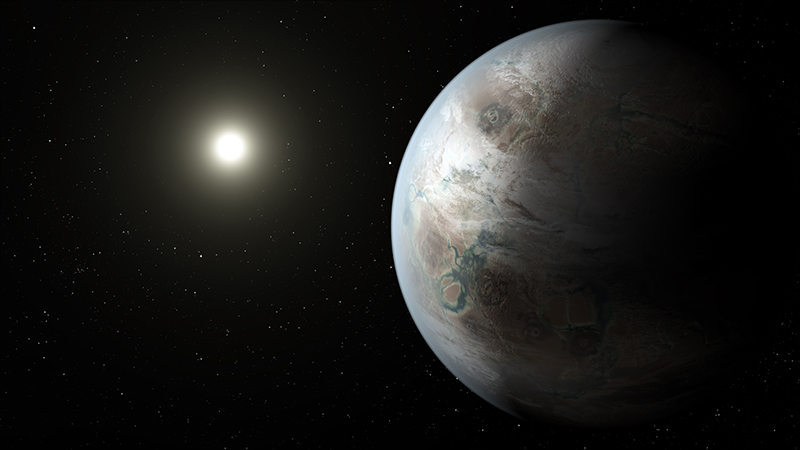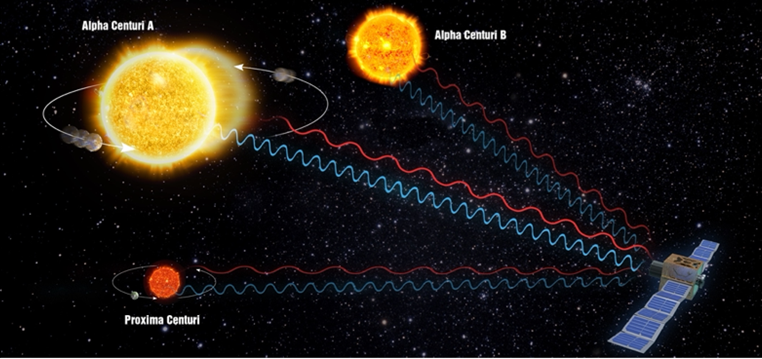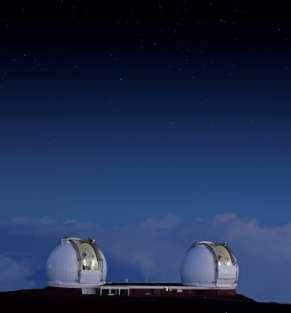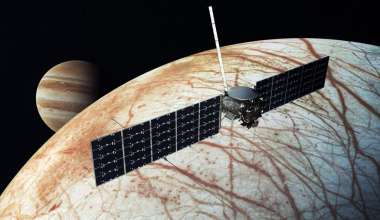Thirty years ago, astronomers made the first definitive observations of exoplanets, inspiring questions about the existence of Earth-like planets and the likelihood of lifeforms beyond the solar system. Since then, the number of detected exoplanets continues to rise, with over 5,000 currently confirmed and numerous more to be surveyed.
Experts at The Aerospace Corporation are currently working as part of a broader team to build a tool that leverages optical frequency comb (OFC) technology to aid in the hunt for exoplanets. Known as an Astrocomb, the tool is a laser that produces a rainbow of light at highly stable, uniformly spaced frequencies such that its spectrum resembles the teeth of a comb. This “spectral ruler” is compared with light from planet-hosting stars to measure the wobble caused by orbiting exoplanets. The project is sponsored by a grant from the Heising-Simons Foundation in a joint effort between Aerospace, the W.M. Keck Observatory, Caltech, Jet Propulsion Laboratory (JPL), and UCLA.
“Our Astrocomb will provide astronomers the tool they need to turn infrared spectrographs into instruments for planet-hunting. A wider class of stars potentially hosting exoplanets can be observed by looking further into the near-infrared part of the spectrum,” said Dr. Stephanie Leifer, Senior Project Leader in Aerospace’s Research and Technology Collaboration Office of the Physical Sciences Laboratories and the project’s Principal Investigator. “On a broader scope, the Nobel Prize-winning OFC is making its way into next-generation technology for a lot of Aerospace’s customers. Aerospace’s demonstrated interest in OFC technology helps the corporation remain at the forefront.”

Shedding Light on Exoplanet Identification
A spectrograph breaks down light into a rainbow of different colors. Each type of star has a unique signature represented by its pattern of spectral lines. When the star wobbles, its light is Doppler-shifted, making those lines appear bluer or redder as it moves closer or further away from observers on Earth. Noting these changes can help scientists identify if there is a planet orbiting that star.
This exoplanet-searching technique—called the radial velocity method—was awarded a Nobel Prize in 2019 and is the only known way to determine from ground-based observatories whether an exoplanet is rocky like the Earth or a gas planet like Neptune. Even so, the search for exoplanets has other obstacles scientists must navigate.

“In general, stars are noisy and can create shifts that mimic Doppler shifts but actually aren’t. There’s also a large class of smaller and cooler stars that are candidates for hosting planets, but their peak emissions are in the infrared,” said Leifer. “Since stars are quieter in the infrared than in the visible spectrum, our Astrocomb will enable scientists to observe stars along a broader spectrum to help build confidence in detecting exoplanets and for characterizing them.” The new Astrocomb is the reddest yet, able to go further into the infrared than any other Astrocomb deployed to date.
Combing Through the Universe
The Astrocomb will offer the spectrograph stability by serving as a highly sensitive calibration source. The team fully achieved their intended spectrum in the spring, producing all of the wavelengths necessary to calibrate the spectrograph.
The tool is now undergoing validation and verification testing within the lab and will be installed and commissioned at the W.M. Keck Observatory this fall. The Astrocomb will work with Keck’s Near Infrared Spectrometer (NIRSPEC), sleuthing for exoplanets around cooler, quieter stars. Eventually, this OFC will be paired with Keck’s High-resolution Infrared Spectrograph for Exoplanet Characterization (HISPEC) that is currently under development.

While the installation of the Astrocomb begins an exciting new chapter for exoplanet searches, it also comes at the beginning of a movement towards utilizing OFCs in space. Looking towards the future, Aerospace is studying flight qualification of commercially available OFCs through its CombSat program.
This technology holds enormous potential—beyond serving as a calibration source—for a wide range of space applications. Because OFCs can divide a second into smaller pieces and translate that data into the RF domain where it can be processed with standard high-speed electronics, OFCs can measure time and frequency at higher resolution than current standards.
“This tool is relevant to efforts related to position, navigation and timing, space domain awareness, optical communication—you can do precision formation flying, more precise ranging, and new science with comb-based instruments. There are many untapped opportunities for this technology,” said Leifer. “Now that OFCs are widely available as a commercial product from a growing list of companies, both in the U.S. and abroad, Aerospace has a real opportunity to serve its customers by helping move this technology into space.”









